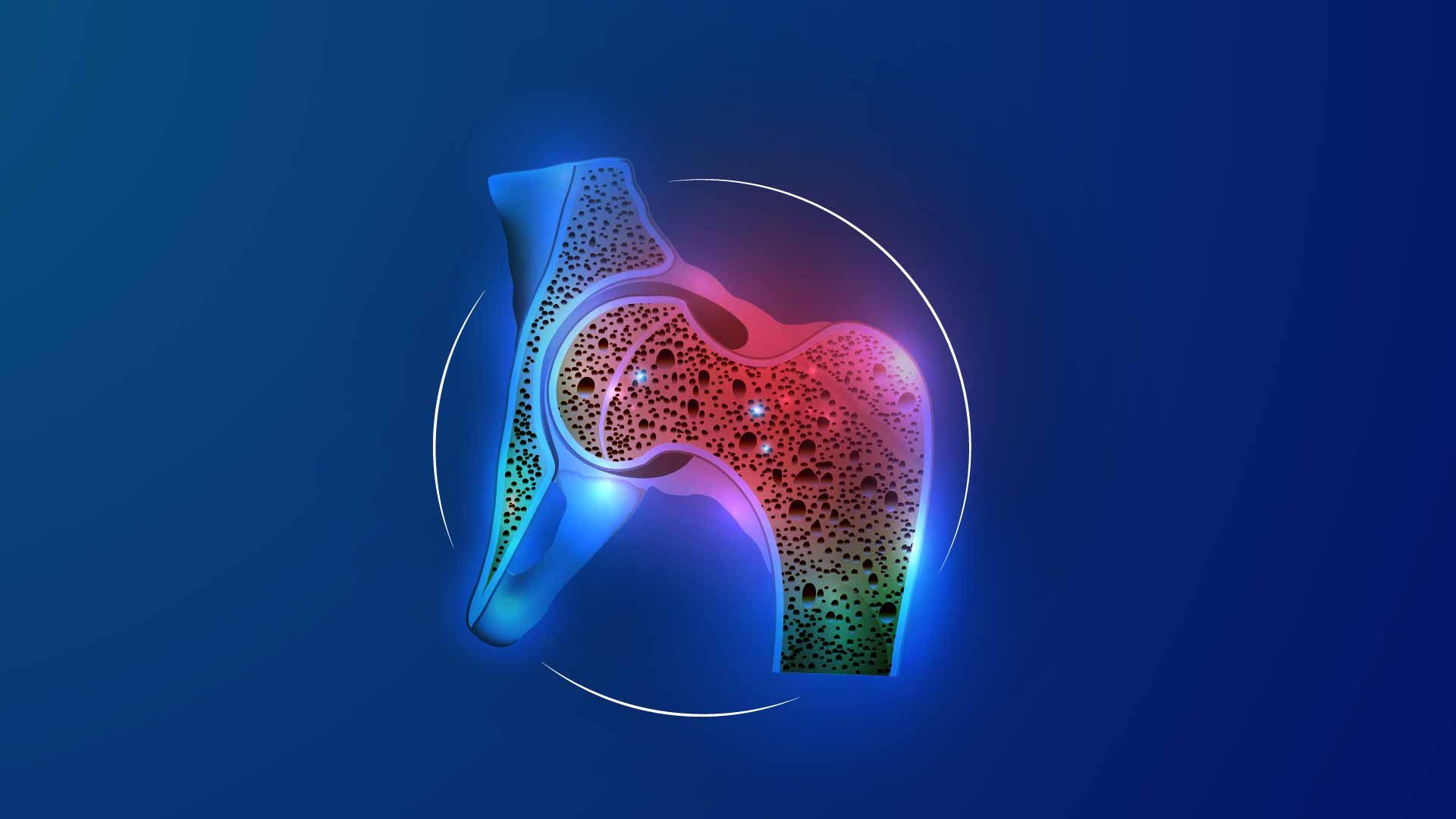
Decoding Osteoporosis: Early Care for Stronger Bones and Healthier Life
Introduction
Osteoporosis—meaning ‘porous bone’—is a condition where bones gradually lose density and strength, making them fragile, brittle, and more prone to fractures.1,2 Often called the ‘silent disease’, it typically progresses without symptoms until a fracture occurs—most commonly in the hip, spine, or wrist.2 Loss of bone density is a gradual process, that can worsen when the body does not produce enough for proper bone formation, and most commonly manifests in old age. 2
Over 200 million people worldwide are affected by this progressive disease, and women—especially postmenopausal women—are more susceptible to bone loss.3,4 An estimated 70% of those over the age of 80 are affected by osteoporosis.1
Osteoporosis and osteoarthritis are distinct conditions, although they are often confused due to similar-sounding terms. Osteoporosis affects bone density, making bones fragile and porous, and more prone to fractures, while osteoarthritis damages joint cartilage and surrounding tissues, leading to pain, stiffness, and reduced mobility. A person can have both conditions, but they impact the body in different ways and might require different treatment approaches.
Who is at Risk for Osteoporosis?
Bone tissue, much like the cells in our bodies, is continuously broken down and rebuilt. With osteoporosis, this balance is disrupted, and bone breakdown outpaces new formation.1,4 Several factors contribute to this, with the prominent ones being ageing, hormonal fluctuations, poor lifestyle, diet, ethnicity, deficiencies, biological sex, and existing medical conditions and medications.4
Bone density peaks around age 30 and naturally declines afterward, making osteoporosis a progressive disease as one grows older. Women are more susceptible, especially after menopause, and lower oestrogen in women post-menopause and reduced testosterone in men can increase risk. Low calcium or vitamin D intake in the earlier decades, smoking, excess alcohol, and sedentary habits all weaken bones, while disorders like rheumatoid arthritis or long-term corticosteroid use also contribute to increased risk of osteoporosis.1,4
Race and genetics are risk factors that cannot be changed, but managing lifestyle and diet can go a long way. Indians are especially susceptible to this disease, with osteoporosis occurring in Indians around 10-20 years earlier than in Western populations. It is estimated that 61 million people in India have osteoporosis, and a whopping 80% of them are women.5
Early Detection Can Improve Outcomes
Early indicators of osteoporosis include a curving spine, gradual loss of height, persistent back pain due to vertebral collapse, and bones that fracture easily. 4 Although this is a silent disease, detecting these signs early allows timely intervention. Bone density scans are important after age 65, and may be recommended earlier for women at higher risk or for men around age 70.6 These scans are critical for diagnosis before fractures occur. Depending on individual needs, clinicians may recommend medications, bone-strengthening supplements, or hormone treatment to help the body replenish the bones on its own.6
Preventive measures such as maintaining sufficient calcium and vitamin D intake through diet or supplements, engaging in regular strength and resistance training, implementing fall-prevention strategies, managing diabetes, and avoiding smoking or excessive alcohol can greatly boost your body’s resilience against osteoporosis.3,6 According to research, smokers face up to twice the risk of developing osteoporosis compared with non-smokers, a modifiable factor that highlights the immense importance of lifestyle choices.3 Early and proactive management not only preserves bone strength but can also reduce healthcare costs, hospitalisations, and long-term disability.
Osteoporosis Increases the Risk of Fragility Fractures
Osteoporosis significantly increases the risk of fractures during everyday activities. This fragility stems from the progressive weakening of internal bone structure that leaves the skeleton porous and unable to withstand even minor stresses. Minor accidents such as slipping on a wet floor, minor bumps, lifting a heavy bag, or even coughing forcefully can result in broken bones.7,8 Therefore, routine falls from low heights or low-impact injuries can become major trauma events, often requiring surgical intervention and long rehabilitation periods.
In advanced cases, a single fall can cause multiple fractures—called ‘fragility fractures’— necessitating several trauma implants to stabilise the bones. Unfortunately, patients suffering fragility fractures are found to be at higher risk of developing secondary fractures, as the already-weakened bone is further impacted.9 Such injuries can profoundly affect quality of life, leading to prolonged immobility, chronic pain, and loss of independence.
How do Trauma Implants Support Osteoporotic Fractures?
When osteoporotic fractures occur, surgical stabilisation plays a vital role in restoring mobility and independence. Orthopaedic trauma implants such as screws, plates, rods, and intramedullary nails (or rods) are used to secure broken bones and promote healing. In severe cases, hip fractures, common in osteoporosis, might require partial or total joint replacement. The choice of implant depends on factors including bone quality, fracture type, and patient health.
In osteoporotic fracture care, reliable implants are crucial as low-density bones may pose a challenge for traditional fixation methods.10 However, newer technologies have been developed to improve outcomes. Locking plates and advanced intramedullary nails offer stronger, more stable fixation by reducing implant loosening and minimising stress on already fragile bone.10,11 These innovations not only support faster rehabilitation but may also lower the likelihood of repeat fractures, helping patients regain function and independence after osteoporotic trauma.
Meril’s Advanced Trauma Systems for Fracture Care
Meril’s trauma portfolio addresses the challenges of treating osteoporotic fractures through advanced stabilisation systems engineered for both typical and fragile bone conditions. which comprise stabilising locking plates and nails, designed to address fractures even in fragile or low-density bones. The KET™ Plate and Screws System offers a range of body part-specific locking plates and screws designed to optimise fracture healing while offering controlled flexibility that accommodates bone recovery, even in complex or osteoporotic cases. The design is aimed at stabilising fractures securely while reducing implant-related stress on weakened bone.
Complementing this, the KET SS Humerus Nail System is a rod designed to fix fractures in the long arm bone (humerus). Its specialised blade design is aimed at enhancing anchoring stability in weaker, osteoporotic bone, supporting reliable fixation where traditional nails may not achieve sufficient hold.
Together, these innovations reflect Meril’s commitment to advancing trauma care by equipping surgeons with reliable, evidence-based tools designed to improve fixation reliability, promote early mobility, and support patient recovery after osteoporotic fractures.
As osteoporosis continues to pose a significant global health challenge, patient-centric technological advancements combined with timely diagnosis, preventive lifestyle measures, and appropriate medical care, can help reduce fracture complications and restore quality of life. With awareness, better choices, and advanced solutions, stronger bones and healthier lives are within reach for you.
References
- https://www.ncbi.nlm.nih.gov/books/NBK441901/
- https://www.bonehealthandosteoporosis.org/patients/what-is-osteoporosis/
- https://pmc.ncbi.nlm.nih.gov/articles/PMC11677826/
- https://www.mayoclinic.org/diseases-conditions/osteoporosis/symptoms-causes/syc-20351968
- https://pmc.ncbi.nlm.nih.gov/articles/PMC8910053/
- https://www.mayoclinic.org/diseases-conditions/osteoporosis/diagnosis-treatment/drc-20351974
- https://www.nia.nih.gov/health/osteoporosis/osteoporosis
- https://www.ncbi.nlm.nih.gov/books/NBK279529/
- https://www.osteoporosis.foundation/health-professionals/fragility-fractures
- https://doi.org/10.1007/s43465-024-01295-0
- https://doi.org/10.1097/BOT.0000000000002228



